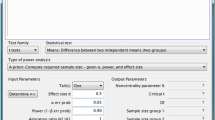Abstract
Randomization tests have recently been adapted for use in the analysis of single-subject data. The advantages of these tests lie in their ease of implementation and interpretation as well as their freedom from underlying distributions. Even though numerous articles and books have explicated randomization test procedures, due to the lack of appropriate examples, very little use of these procedures has been made by applied behavior analysts. Data sets reported in a prominent applied behavior journal are used to demonstrate the application of randomization tests to the following three single-subject design models: (a) two-phase random intervention point, (b) multiple phase, and (c) multiple phase with a predicted order of effect size.
Similar content being viewed by others
References
Bakeman, R. Untangling streams of behavior: Sequential analyses of observational data. In G. P. Sackett (Ed.),Observing behavior: Data collection and analysis methods, Vol. 2. Baltimore: University Park Press, 1978.
Bradley, J. V.Distribution-free statistical tests. Reading, Mass.: Addison-Wesley, 1967.
Conover, W. J.Practical nonparametric statistics. New York: John Wiley & Sons, 1971.
Edgington, E. S. Randomization tests for one-subject operant experiments.The Journal of Psychology 1975,90 57–68.
Edgington, E. S. Random assignment and statistical tests for one-subject experiments.Behavioral Assessment 1980a,2 19–28.
Edgington, E. S.Randomization tests. New York: Marcel Dekker, 1980b.
Edgington, E. S. Validity of randomization tests for one-subject experiments.Journal of Educational Statistics 1980c,5 235–251.
Elashoff, J. D., and Thoresen, C. E. Choosing a statistical method for analysis of an intensive experiment. In T. R. Kratochwill (Ed.),Single subject research: Strategies for evaluating change. New York: Academic Press, 1978.
Furlong, M. J., and Wampold, B. E. An analysis of the interpretation procedures in visual inference. Submitted for publication, 1981.
Gentile, J. R., Roden, A. H., and Klein, R. D. An analysis of variance model for the intrasubject replication design.Journal of Applied Behavior Analysis 1972,5 193–198.
Glass, G. V., Willson, V. L., and Gottman, J. M.Design and analysis of time series experiments. Boulder, Colo.: Associated University Press, 1975.
Gottman, J. M., and Glass, G. V. Analysis of interrupted time-series experiments. In T. R. Kratochwill (Ed.),Single subject research: Strategies for evaluating change. New York: Academic Press, 1978.
Gottman, J. M., and Notarius, C. Sequential analysis of observational data using Markov chains. In T. R. Kratochwill (Ed.),Single subject research: Strategies for evaluating change. New York: Academic Press, 1978.
Hall, R. V., Panyan, M., Rabon, D., and Broden, M. Instructing beginning teachers in reinforcement procedures which improve classroom control.Journal of Applied Behavior Analysis 1968,1 315–322.
Jones, R. R., Vaught, R. S., and Weinrott, M. Time series analysis in operant research.Journal of Applied Behavior Analysis 1977,10 151–166.
Jones, R. R., Weinrott, M., and Vaught, R. S. Effects of serial dependency on the agreement between visual and statistical inference.Journal of Applied Behavior Analysis 1978,11 277–283.
Kazdin, A. E. Statistical analyses for single-case experimental designs. In M. Hersen and D. Barlow (Eds.),Single case experimental designs. New York: Pergamon Press, 1976.
Kratochwill, T. R., and Brody, G. H. Single subject designs: A perspective on the controversy over employing statistical inference and implications for research and training in behavior modification.Behavior Modification 1978,2 291–307.
Levin, J. M., Marascuilo, L. A., and Hubert, L. J. N = Nonparametric randomization tests. In T. R. Kratochwill (Ed.),Single subject research: Strategies for evaluating change. New York: Academic Press, 1978.
Mann, R. A. The behavior-therapeutic use of contingency contracting to control an adult behavior problem: Weight control.Journal of Applied Behavior Analysis 1972,5 99–109.
Marascuilo, L. A., and McSweeney, M.Nonparametric and distribution-free methods for the social sciences. Monterey, Calif.: Brooks/Cole, 1977.
Revusky, S. H. Some statistical treatments compatible with individual organism methodology.Journal of the Experimental Analysis of Behavior 1967,10 319–330.
Solomon, R. W., and Wahler, R. G. Peer reinforcement control of classroom behavior.Journal of Applied Behavior Analysis 1973,6 49–56.
Wampold, B. E., and Furlong, M. J. The heuristics of visual inference.Behavioral Assessment 1981,3 79–92.
Author information
Authors and Affiliations
Rights and permissions
About this article
Cite this article
Wampold, B.E., Furlong, M.J. Randomization tests in single-subject designs: Illustrative examples. Journal of Behavioral Assessment 3, 329–341 (1981). https://doi.org/10.1007/BF01350836
Accepted:
Issue Date:
DOI: https://doi.org/10.1007/BF01350836




